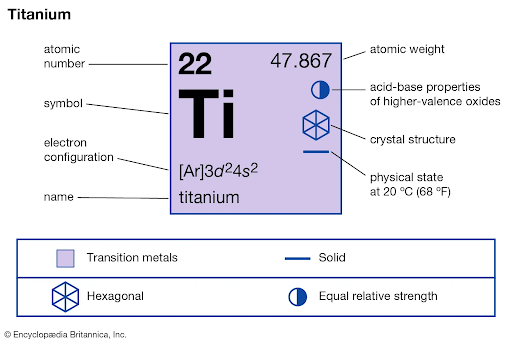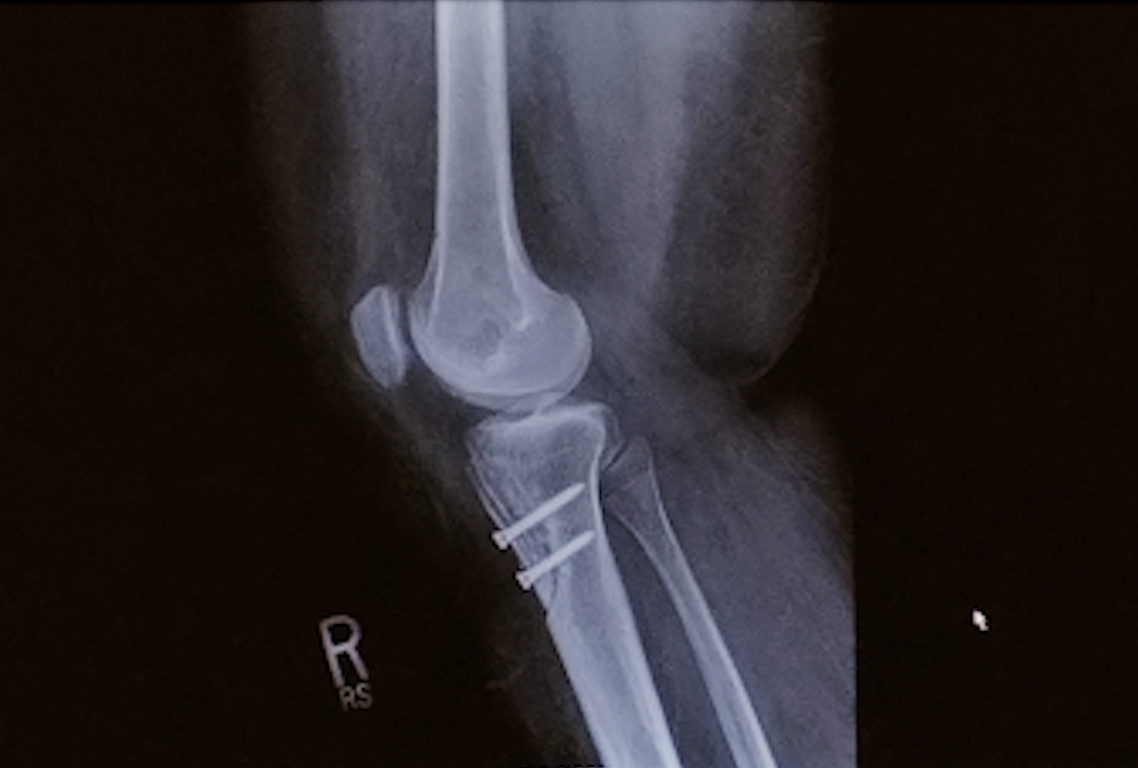Time to read: 5 min
Titanium (Ti) is a shiny metal with a high corrosion resistance and high strength. Titanium is impressively lightweight and biocompatible. Titanium is a transition metal with atomic number 22, period 4 and group 4 on the periodic table. It has a hexagonal crystal structure and two electrons in its fourth orbital, with an electron configuration of 1s2 2s2 2p6 3s2 3p6 3d2 4s2. Titanium has common chemical properties with Zirconium.

Titanium is found in a variety of compounds:
| Titanium Compound | Chemical Formula | Properties | Common Applications |
| Titanium Oxide | TiO2 | Cost-effective, chemically inert, non-toxic | Food pigment (produces white), sunscreen, paint, roofing, plastic additives, chemical catalysts |
| Titanium Chloride (Titanium Halide Family) | TiCl4 | Heavy, colorless, toxic, strong odor, fumes in air | Used to produce raw Titanium (intermediate product), formation of Titanium Dioxide (reaction with water), production of plastic polymers |
| Titanium Iodides (Titanium Halide Family) | TiI4 | Insoluble, hydrolyzes in water | Separating the Iodide gives pure Titanium (Ti + 2I2🡪TiI4) |
| Titanium Fluoride (Titanium Halide Family) | TiF4 | Fluorides have a corrosive effect on Titanium; at high temps forms a compound | Source for Ti metal production, currently being investigated for dental applications |
| Titanium Sulfide | TiS2 | Electrical properties, unstable, strong odor, hydrolyzes in water to make hydrogen sulfide | Cathode for rechargeable lithium batteries |
| Titanium Nitride | TiN | High hardness, electrically conductive, low coefficient of friction, high melting point, thermodynamically stable | Coating for surgical equipment or aesthetics to produce gold finish |
1Provides an example, may not be an exhaustive list of all chemical compounds
Ti is mined from primarily unconsolidated sediments (loosely arranged layers i.e. soft rock) in a wet dredge or dry mining operation, depending on the water table height. Titanium is commonly utilized for CNC machining parts for the aerospace and medical industries. Prevalent utilizations include:
- Medical Screws
- Turbine Blades
- Pacemaker Cases
- Engine Components
- Dental Implants
- Medical Implants
Titanium for Medical Applications – Why is It Biocompatible?

Titanium is the most biocompatible metal due to several reasons. First, Titanium has superior corrosion resistance due to its low electrical conductivity which allows for electrochemical oxidation. This electrochemical oxidation provides a passive, oxide layer which equates to corrosion resistance. Even more interesting is the fact that this oxide layer is retained at the pH levels in the human body, so the oxide layer doesn’t break down and therefore the metal is protected and doesn’t degrade itself. Adding to it’s medical industry application benefits, Titanium is also osteoconductive, meaning it actually promotes bone growth around an implant itself, for smooth integration into the skeletal structure the implant is placed.
Titanium also has a high strength for its relatively low density, making it a common choice for medical implant applications where strength is required, such as joint replacements, screws, and bone plates. Another Titanium mechanical property strength for medical applications is its elastic modulus. The goal of designing an implant is for it to have a similar elastic modulus as the surrounding bone at the installation location. When the elastic modulus of the implant is higher, stress shielding, and bone resorption may occur. Titanium alloys which contain Nb, Ta, and Zr, which act as β phase stabilizers, are often chosen for implants due to their low elastic modulus, high strength and superior corrosion resistance – all leading to a strengthened biocompatibility.
2Shared with permission
Fictiv is proud to offer precision CNC machining to meet tight tolerances required by the aerospace and medical industries. Get an instant quote now or click here to learn more about our impressive lineup of CNC machining services.
Titanium for Aerospace Applications – Why is it so Popular?

Titanium is a relatively newer choice for aerospace applications. It’s corrosion resistance and strength, as expressed above, also make it a logical and common choice for aerospace CNC machining. More specifically, the low density (around 60% of steel’s density), coupled with the high strength makes it ideal for aerospace applications where weight is critical, and strength is also required. In addition, Titanium has a great fatigue strength, fracture toughness, and crack propagation resistance, further enhancing its benefits to the aerospace industry.
Ti also has superior resistance to extreme temperatures. This temperature resistance allows aerospace components to resist low temperature cracking or embrittlement as well as high temperature loss of strength, distortion, or melting.
Titanium is a common choice for aerospace applications as it has similar physical characteristics to the commonly used CFRP (carbon fiber-reinforced polymers) utilized in the aerospace industry now. The similarity in features, such as coefficient of thermal expansion, allows for a more uniform stress distribution on weight bearing members and prevents or reduces potential strain.
Common applications for aerospace components include airframe materials such as frames and joints, where high strength is required, and weight savings is crucial for fuel economy. This is more important each year, as new sustainability initiatives and goals are released to reduce carbon emissions. Engine components are also now commonly made with titanium alloys, such as turbofan and compressor parts.
Tips for CNC Machining Titanium
As titanium has gained popularity, CNC machining vendors have had to learn how to optimally machine it. Due to its physical properties, titanium can be challenging to machine. A few of the common problems experienced during titanium CNC machining are:
- Titanium is a poor thermal conductor but generates a lot of heat when machined
- This can cause premature tool wear due to excess generated heat exposure at the tool’s cutting edge – more of the heat generated here is absorbed by the tooling itself, rather than the generated chips
- Titanium tends to smear during CNC machining which can cause machined chips to embed themselves into the tooling
- This may cause edge line problems when the tooling is re-entering the titanium workpiece
- Titanium has a higher elasticity so it tends to have a higher risk of machining chatter from the CNC machining process
Here are some tips for avoiding problems during CNC machining titanium parts:
- Lower your cutting speed if you are experiencing excess heat buildup or smearing; also try to glide softly into the entry point, instead of directly feeding into the stock
- Sharpen your cutting edges if you are seeing smearing or edge line problems
- Perform frequent tooling inspection and maintenance or replacement when machining titanium and replace cutting edges when you first see wear
- Fine tune your feed rates, likely based on trial and error; this may help to reduce heat buildup or smearing as well
- Utilize a high pressure, large flow volume of coolant with a preferred spindle and tool setup
- Reduce radial engagement to reduce the time that the cutting edge can generate heat, therefore allowing it to cool before the cutting tool re-enters the titanium workpiece
- This may also allow for an increase in surface speed, without impacting tooling temperature significantly
- Ensure every single piece of equipment that completes the machining setup, including the workpiece itself, are all stable. Stability and rigidity in the setup will reduce vibrations, tolerance issues and heat generation
- Utilize conventional, or climb milling, to produce a greater amount of material at the entry point of the mill (for greater heat transfer to the chip) and thinner amount of material at the exit point of the mill lower the risk of chip adhesion issues
- Design in chamfers where you can to reinforce tip #8
- Pay attention to axial depth: change it for each cut, to prevent tooling oxidation; also follow the ratio 8:1 around thin walls or unsupported features to avoid deformation










